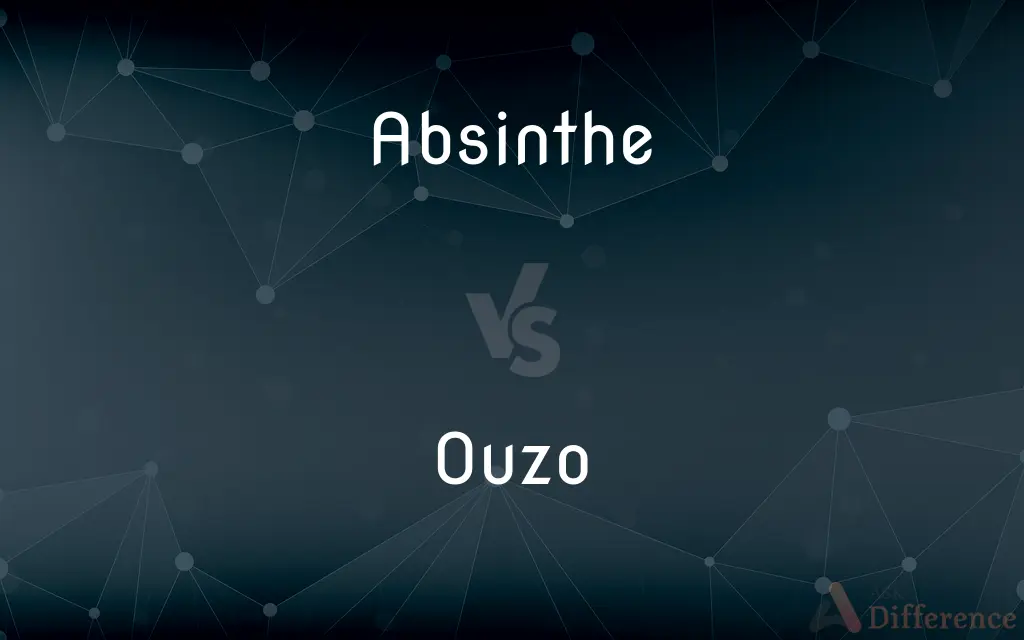Absinthe vs. Ouzo — What's the Difference?
By Tayyaba Rehman — Updated on November 7, 2023
Absinthe is a strong, anise-flavored spirit with wormwood, while Ouzo is a Greek anise-flavored aperitif.

Difference Between Absinthe and Ouzo
Table of Contents
ADVERTISEMENT
Key Differences
Absinthe is traditionally a high-proof spirit known for its green color and anise flavor, often associated with historical artistic movements. Ouzo, distinctly Greek, is a lower-proof aperitif, clear until water is added, which turns it milky white.
Historically, absinthe was believed to cause hallucinations, contributing to its mystique and the rituals surrounding its consumption. Ouzo lacks the notorious reputation of absinthe and is enjoyed widely in Greece, often as part of a social gathering or meal.
Absinthe is often served with water dripped over a sugar cube, which balances its bitterness and releases its botanical aromas. Ouzo is usually served neat, sometimes with a splash of water, enhancing its licorice flavor without the need for additional sweeteners.
The production of absinthe involves a complex distillation process including botanicals like grand wormwood, which imparts a distinctive flavor. Ouzo production involves distilling alcohol with anise and sometimes other spices or botanicals, but without wormwood.
Absinthe's popularity declined in the early 20th century due to bans and legal restrictions, but it has experienced a revival. Ouzo has maintained steady popularity in Greece and among Greek communities worldwide, symbolizing Greek hospitality and culture.
ADVERTISEMENT
Comparison Chart
Origin
Swiss or French.
Greek.
Main Flavor
Anise and wormwood.
Anise.
Color
Naturally green.
Clear to milky with water.
Alcohol Content
Generally higher (45-74% ABV).
Lower (37.5-50% ABV).
Cultural Association
Bohemian and artistic movements.
Greek hospitality.
Preparation/Consumption
With water and sugar.
Neat or with water.
Legal Status (historically)
Banned in the early 20th century.
Always legal.
Serving Ritual
La louche (water drip over sugar).
Straight or with water.
Botanicals
Wormwood, anise, fennel, others.
Anise, sometimes others.
Associated Effects
Falsely believed to be hallucinogenic.
None.
Compare with Definitions
Absinthe
A once-banned alcoholic beverage made with wormwood and anise.
Absinthe was once thought to inspire madness among its drinkers.
Ouzo
A clear spirit that turns milky when water is added.
He was intrigued by the way the ouzo turned milky as water was mixed in.
Absinthe
A drink associated with historic artistic and literary figures.
Absinthe was the favored drink of many 19th-century writers.
Ouzo
A beverage often consumed with small plates of food or meze.
Ouzo is best enjoyed with a variety of meze on a sunny Mediterranean afternoon.
Absinthe
A high-proof spirit with a distinctive green color and anise flavor.
The artist sipped absinthe as he pondered his next painting.
Ouzo
The national liquor of Greece, symbolizing Greek culture.
Ouzo is more than a drink; it's a symbol of Greek hospitality.
Absinthe
An aromatic spirit that has experienced a modern resurgence.
Despite its controversial past, absinthe has become quite trendy in craft cocktail bars.
Ouzo
A traditional Greek aperitif with a strong anise flavor.
After dinner, they ordered ouzo to complete the authentic Greek dining experience.
Absinthe
A liquor that is part of a traditional preparation ritual involving water and sugar.
They prepared the absinthe in the traditional manner, which fascinated the guests.
Ouzo
An alcoholic drink served neat or on ice.
In the heat of the Greek summer, a glass of chilled ouzo is particularly refreshing.
Absinthe
Absinthe (, French: [apsɛ̃t] (listen)) is historically described as a highly alcoholic spirit (45–74% ABV / 90–148 U.S. proof). It is an anise-flavoured spirit derived from plants, including the flowers and leaves of Artemisia absinthium ("grand wormwood"), together with green anise, sweet fennel, and other medicinal and culinary herbs.Absinthe traditionally has a natural green color but may also be colorless.
Ouzo
Ouzo (Greek: ούζο, IPA: [ˈuzo]) is a dry anise-flavoured aperitif that is widely consumed in Greece and Cyprus. It is made from rectified spirits that have undergone a process of distillation and flavoring.
Absinthe
A perennial aromatic Eurasian herb (Artemisia absinthium) in the composite family, naturalized in North America and having pinnatifid, silvery, silky leaves and numerous nodding flower heads. Also called wormwood.
Ouzo
A Greek aniseed-flavoured spirit.
Absinthe
A green liquor having a bitter anise or licorice flavor and a high alcohol content, prepared from absinthe and other herbs, prohibited in many countries when containing thujone because of its alleged toxicity.
Ouzo
A colorless, unsweetened Greek liqueur flavored with anise.
Absinthe
The herb absinthium Artemisia absinthium (grande wormwood); essence of wormwood.
Ouzo
(uncountable) An anise-flavoured aperitif, originating in Greece.
Absinthe
(figurative) Bitterness; sorrow.
Ouzo
(countable) A serving of this drink.
Absinthe
A distilled, highly alcoholic, anise-flavored liquor originally made from grande wormwood, anise, and other herbs.
Ouzo
Anise-flavored Greek liquor
Absinthe
(color) A moderate yellow green. 88c641
Absinthe
(US) Sagebrush.
Absinthe
Aromatic herb of temperate Eurasia and North Africa having a bitter taste used in making the liqueur absinthe
Absinthe
Strong green liqueur flavored with wormwood and anise
Common Curiosities
What is absinthe?
Absinthe is a high-alcohol spirit made from anise, wormwood, and other botanicals.
How is absinthe traditionally served?
Traditionally, absinthe is served with water dripped over a sugar cube into the glass.
How is ouzo typically consumed?
Ouzo is usually served neat, sometimes with a splash of water.
What is ouzo?
Ouzo is a Greek anise-flavored aperitif that is often served with small dishes.
Was absinthe illegal?
Absinthe was banned in many countries in the early 20th century, but it has since been legalized.
Is ouzo drunk in any special way?
While there's no ritual, ouzo is often accompanied by small plates of food.
Can absinthe really cause hallucinations?
No, this is a myth; the hallucinogenic effects of absinthe were greatly exaggerated.
What color is absinthe?
Absinthe is typically green, though some varieties are colorless.
Is ouzo similar to absinthe in flavor?
Both have anise flavors but differ due to absinthe's additional botanicals and higher alcohol content.
Does ouzo change color when mixed with water?
Yes, ouzo turns from clear to a milky white when water is added.
Are there different qualities of absinthe?
Yes, like most spirits, absinthe comes in various qualities and potencies.
Is there a best time to drink ouzo?
Ouzo is typically enjoyed in the afternoon or early evening, especially as an aperitif.
What does absinthe taste like?
It has a complex taste with a strong flavor of anise, herbal and sometimes bitter notes.
What does ouzo taste like?
Ouzo tastes primarily of anise and has a slightly sweet flavor.
Are there cocktails made with absinthe or ouzo?
Yes, both can be used in cocktails, though absinthe is often used in smaller quantities due to its strength.
Share Your Discovery

Previous Comparison
Ranking vs. Rating
Next Comparison
Plan vs. MapAuthor Spotlight
Written by
Tayyaba RehmanTayyaba Rehman is a distinguished writer, currently serving as a primary contributor to askdifference.com. As a researcher in semantics and etymology, Tayyaba's passion for the complexity of languages and their distinctions has found a perfect home on the platform. Tayyaba delves into the intricacies of language, distinguishing between commonly confused words and phrases, thereby providing clarity for readers worldwide.















































